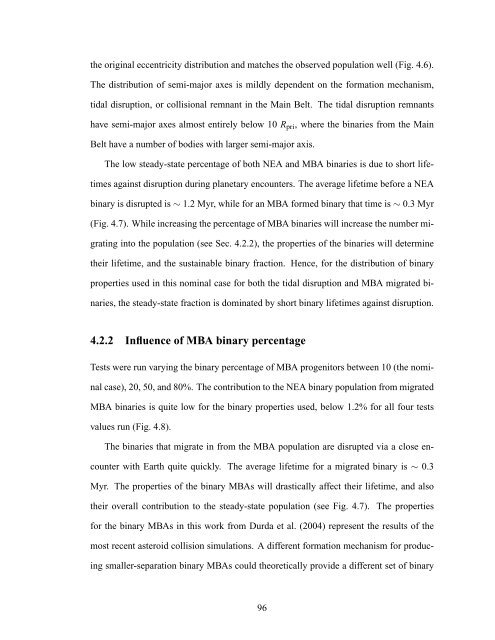Forming Binary Near-Earth Asteroids From Tidal Disruptions
Forming Binary Near-Earth Asteroids From Tidal Disruptions
Forming Binary Near-Earth Asteroids From Tidal Disruptions
You also want an ePaper? Increase the reach of your titles
YUMPU automatically turns print PDFs into web optimized ePapers that Google loves.
the original eccentricity distribution and matches the observed population well (Fig. 4.6).The distribution of semi-major axes is mildly dependent on the formation mechanism,tidal disruption, or collisional remnant in the Main Belt. The tidal disruption remnantshave semi-major axes almost entirely below 10 R pri , where the binaries from the MainBelt have a number of bodies with larger semi-major axis.The low steady-state percentage of both NEA and MBA binaries is due to short lifetimesagainst disruption during planetary encounters. The average lifetime before a NEAbinary is disrupted is ∼ 1.2 Myr, while for an MBA formed binary that time is ∼ 0.3 Myr(Fig. 4.7). While increasing the percentage of MBA binaries will increase the number migratinginto the population (see Sec. 4.2.2), the properties of the binaries will determinetheir lifetime, and the sustainable binary fraction. Hence, for the distribution of binaryproperties used in this nominal case for both the tidal disruption and MBA migrated binaries,the steady-state fraction is dominated by short binary lifetimes against disruption.4.2.2 Influence of MBA binary percentageTests were run varying the binary percentage of MBA progenitors between 10 (the nominalcase), 20, 50, and 80%. The contribution to the NEA binary population from migratedMBA binaries is quite low for the binary properties used, below 1.2% for all four testsvalues run (Fig. 4.8).The binaries that migrate in from the MBA population are disrupted via a close encounterwith <strong>Earth</strong> quite quickly. The average lifetime for a migrated binary is ∼ 0.3Myr. The properties of the binary MBAs will drastically affect their lifetime, and alsotheir overall contribution to the steady-state population (see Fig. 4.7). The propertiesfor the binary MBAs in this work from Durda et al. (2004) represent the results of themost recent asteroid collision simulations. A different formation mechanism for producingsmaller-separation binary MBAs could theoretically provide a different set of binary96












